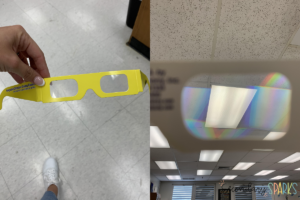A holiday is a great excuse to mix things up in your classroom. It’s a great way to take an exciting lesson or topic more interesting for your students because holidays always feel like a special day. St Patrick’s Day is no exception. There are tons of fun ways to add a little bit of festivity to your old science curriculum with these St. Patrick’s Day middle school science activities while still aligning to your standards.
Studying Light and Making Rainbows
Rainbows are one of those things associated with St. Patrick’s Day so you can make a lesson all about rainbows and how they work! Discuss how rainbows form after a rainy day. Play with prisms and review refraction. Another fun thing I like to do with my students to review light is to show them how white light can be broken up into individual colors. If you have a set of diffraction prism glasses like this in your classroom, you can have your students put them on and look up at the light in your classroom to see how it works. It’s so simple but it gets students excited when they see the rainbows!

Leprechaun Trap STEM
A holiday is always a good day to switch up your usual instruction with a STEM challenge. Have students build a leprechaun trap using simple machines. Provide students with recyclable supplies such as bottles and cardboard. Then, supplement with things like popsicle sticks, rubber bands, paper clips, etc. Group students and give them a time limit to complete the challenge. After completing, make it a competition to see who has the most effective trap!
Leprechaun Genetics
Discuss genetic variation and Punnett squares by having students roll dice to represent different phenotypes of leprechauns. These features can include a long beard, short beard, eye color, shoe size, height, etc. Once students have created their Punnett squares, have them draw their leprechaun and display them as St. Patrick’s day décor!
Build a Simple Potato Battery.
You can create these batteries and then discuss with your students how they can work to power small things like an LED clock. They work by harnessing chemical energy stored in the potato to transform into electrical energy. When materials link copper and zinc are inserted into the potato, the chemical reaction can occur to produce the electrical energy.

Green Energy
Green is the color of St. Patrick’s Day, right? Why not make the day all about “keeping it green” and talking about renewable energy, keeping the planet clean, etc. Infuse some of those human impact standards when you do this. Have students explore renewable energy sources such as solar panels, wind turbines, hydroelectric dams, etc. You can even have students debate with one another to see which renewable energy source would work best in the community you live in.
St. Patrick’s Day Science Stations
If you want to review a bunch of standards in a day with mini activities, stations are the answer. These St. Patrick’s Day stations are the ultimate way to review a lot of content in a single class period. These stations review Earth/Space, Life Science and Physical Science standards. Topics include density, light waves, periodic table, ecology, genetics, photosynthesis, plate tectonics and more! These are great for getting into standardized testing season and reviewing previously taught content. I love using these types of stations with other fun review activities.


Leave a Reply